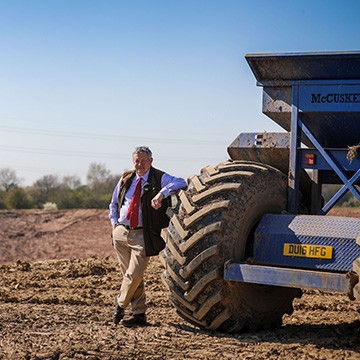Yield mapping: work smarter, not harder


Yield mapping is a smarter and more efficient way to identify where problems might lie, and the best ways to address them. It enables farmers to understand what is going on in their fields, identifying areas that are under performing, over performing or average.
Jon Birchall, Carter Jonas’ Director of Agribusiness has a passion for conservation agriculture and wants to embed new ideas and new technology such as yield mapping into his role.
With many years of experience analysing every part of a farm to evaluate its potential, Jon was named BBC Farmer of the Year in 2010, in recognition of his management of the 800ha Kings Walden Estate in Hertfordshire.
It is more crucial than ever for businesses to focus on how they get the most out of their land, and for some that will mean a new way of thinking. Jon sees his role as helping clients achieve the best possible financial results, but also improving the landscape.
“Of course, Carter Jonas has a long history in farm agency, handling Basic Payment Scheme (BPS) claims and stewardship agreements for example,” Jon says. “We are in a new place now, and I want to bring the best of technology to our farms so we can help, through improved farming practices, to replace some of the lost income when BPS disappears. There are a huge number of things we can start to look at.”
It was 2001 when Jon bought his first yield-mapping combine. “I was the first to shout about how great it was,” he says. “Since then I have generated lots of pretty maps but not done anything with the data.” However, using the resources available through Carter Jonas’ GIS department, the team has been able to marry together historic yield maps and production costs in a single platform to create a net margin per hectare map.
Putting a monetary value on every action is where Jon wants to get to, “everyone is used to seeing nice fields with a single crop in them. I’m proposing that, in the future, a field could have a 16-metre stewardship margin adjacent to the hedge, with a three-metre sacrificial strip adjacent to that for machinery to turn on, minimising the area exposed to compaction. Other stewardship options would be located on the regions of the field which have consistently under performed, and can’t be improved. Yield per hectare is irrelevant, it’s profit per hectare that counts. I know that represents a change of mind-set, but I truly believe that’s what is required.”
Jon admits getting landowners to change their mentality will be a slow burner, but will be encouraged by government policy as well as the financial case. “If I’ve taken land with inherently poor profitability out of the equation, and there’s more land going into environmental schemes, there is no downside,” he added.
If you’re interested in working with Jon on data sharing in order to advance the mapping technology, get in touch on 01743 213284 or jon.birchall@carterjonas.co.uk. The full version of this article is also available at www.carterjonas.co.uk/yield-mapping.



































